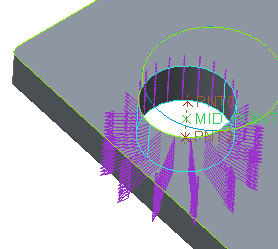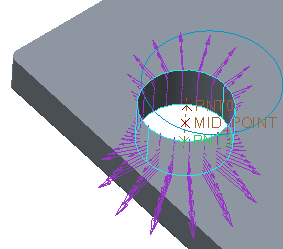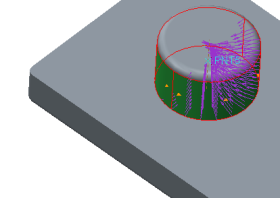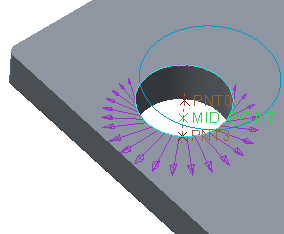Total Bearing Load at Point
A Total Bearing Load at Point (TBLAP) is used to represent the force and moment that one cylindrically shaped part exerts on another. It is an advanced bearing load distribution on cylindrical surfaces or along circular edges/curves that is defined by a resultant force and moment at any selected point in the model.
During an analysis, Creo Simulate applies smoothly distributed tractions to the selected geometry that are statically equivalent to the applied force and moment. The components of the specified force and moment that are perpendicular to the axis are applied as normal tractions, and may vary in the longitudinal direction. The components of the specified force and moment that are parallel to the axis are applied as uniform tangential tractions.
In contrast, the regular bearing load can only have a resultant force, through the center of the reference cylinder or edge and perpendicular to its axis.
TBLAP is available in Native mode only. You can only apply it to cylindrical surfaces or circular edges or curves. Both cylindrical holes and protrusions can be selected as the surface type.
The Total Bearing Load at Point option is available as an advanced distribution type when you select either Surfaces or Edges/Curves as references and then click Advanced on the Force/Moment Load dialog box. When you select Total Bearing Load at Point under Distribution, the dialog box displays the reference point selection and the Ignore Axial Tractions and Ignore Circumferential Tractions check boxes. You can select only one reference point, as in TLAP.
The following figures illustrate the definition of TBLAP on different surface types and with different options selected:
Definition of a TBLAP at the center point of a hole

Definition of a TBLAP off the hole’s center with both axial tractions and circumferential tractions

Definition of a TBLAP on a cylindrical protrusion with perpendicular moment

Definition of a TBLAP along an edge

Click Preview to view the actual distribution of the traction on the hole.
The total bearing load at point is available when moving from integrated mode to standalone Creo Simulate, but you cannot edit the load parameters. However, you can delete a load created in the integrated mode while in the standalone mode. |
The total bearing load at point distribution type allows easier conversion of loads imported from Mechanism. You can apply loads on any type of geometry as regular TLAPs or on holes as total bearing loads at point. |